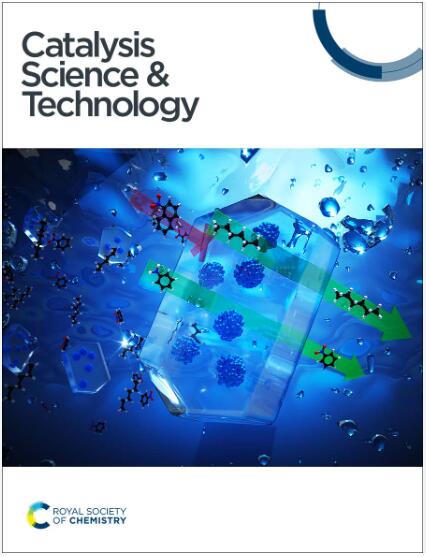通过s型MoO3/g-C3N4异质结与Pt助催化剂†在CO2光还原中实现高CH4选择性
IF 4.4
3区 化学
Q2 CHEMISTRY, PHYSICAL
引用次数: 0
摘要
设计并合成了Pt辅助MoO3/g-C3N4光催化剂(Pt/5MoO3/g-C3N4),用于选择性光催化还原CO2为CH4。采用XRD、XPS、SEM、TEM对催化剂的结构、形貌和化学状态进行了系统分析。MoO3与g-C3N4之间形成s型异质结,有效促进了电荷的分离和迁移,提高了光催化效率。Pt作为助催化剂,促进电荷转移,减少重组,提高CH4选择性。Pt/5MoO3/g- c3n4催化剂的CH4产率为34.9 μmol g−1 h−1,是g- c3n4催化剂的2.2倍,CH4选择性为100%。原位FTIR和XPS分析证实,Pt0是一级催化位点,而MoO3有助于CO2吸附和中间稳定。光电化学实验进一步证实了s型异质结与Pt共催化剂的协同作用,增强了电荷分离,降低了界面电荷转移阻力。Pt/5MoO3/g-C3N4具有优异的稳定性和可回收性。本研究强调了s型异质结工程和Pt共催化剂在提高光催化CO2还原效率和选择性方面的有效性。本文章由计算机程序翻译,如有差异,请以英文原文为准。
Achieving high CH4 selectivity in CO2 photoreduction via S-type MoO3/g-C3N4 heterojunction with Pt co-catalyst†
A Pt-assisted MoO3/g-C3N4 photocatalyst (Pt/5MoO3/g-C3N4) was designed and synthesized for the selective photocatalytic reduction of CO2 to CH4. The structure, morphology, and chemical states of the catalyst were systematically analyzed using XRD, XPS, SEM, and TEM. The formation of an S-type heterojunction between MoO3 and g-C3N4 effectively promoted charge separation and migration, enhancing photocatalytic efficiency. Pt, as a co-catalyst, facilitated charge transfer, reduced recombination, and improved CH4 selectivity. The Pt/5MoO3/g-C3N4 catalyst achieved a CH4 production rate of 34.9 μmol g−1 h−1, 2.2 times higher than that of g-C3N4, with 100% CH4 selectivity. In situ FTIR and XPS analyses confirmed that Pt0 acted as the primary catalytic site, while MoO3 contributed to CO2 adsorption and intermediate stabilization. Photoelectrochemical tests further demonstrated the synergistic effect of the S-type heterojunction and Pt co-catalyst, leading to enhanced charge separation and reduced interfacial charge transfer resistance. Moreover, Pt/5MoO3/g-C3N4 exhibited excellent stability and recyclability. This study highlights the effectiveness of S-type heterojunction engineering and Pt co-catalysts in improving photocatalytic CO2 reduction efficiency and selectivity.
求助全文
通过发布文献求助,成功后即可免费获取论文全文。
去求助
来源期刊

Catalysis Science & Technology
CHEMISTRY, PHYSICAL-
CiteScore
8.70
自引率
6.00%
发文量
587
审稿时长
1.5 months
期刊介绍:
A multidisciplinary journal focusing on cutting edge research across all fundamental science and technological aspects of catalysis.
Editor-in-chief: Bert Weckhuysen
Impact factor: 5.0
Time to first decision (peer reviewed only): 31 days
 求助内容:
求助内容: 应助结果提醒方式:
应助结果提醒方式:


